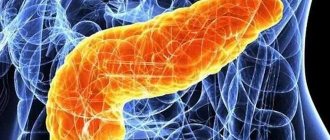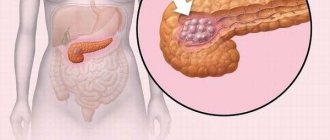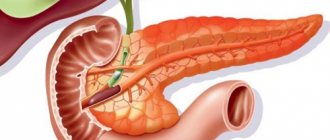When the tail of the pancreas hurts, the condition is accompanied by dysfunction of the endocrine and digestive systems, which is due to the structure of the tissues in this part of the organ.
The pancreas is an important organ related to the digestive and endocrine systems. Structural changes in the organ lead to hormonal disorders or disorders of the process of food absorption. The gland is conventionally divided into three parts: head, body, tail.
Pain in the tail is localized in the left half of the abdomen, sometimes it can radiate to the chest, to the area of the heart, and therefore differential diagnosis is carried out during the examination.
Characteristics of the gland
The pancreas is a large gland located in the abdominal cavity behind the stomach and closely adjacent to the duodenum. The gland is an important organ of the digestive system, producing special enzymes that are involved in the breakdown of proteins, fats and carbohydrates. Among these enzymes are trypsin, chymotrypsin, pancreatic amylase, etc.
The pancreas is also an endocrine gland that produces insulin and one of the counter-insular hormones, glucagon. The ratio of the exocrine and intrasecretory parts of the organ is 9:1. The specificity of the structure of the tail zone of the pancreas is the predominance of the islets of Langerhans in the parenchyma. Their size is 0.1 - 0.2 mm, and the total number of this structural unit in the pancreas ranges from 200 thousand to 1.8 million. The cells of the islets of Langerhans produce hormones that control metabolism in the body. Insulin, glucagon and amylin, which affect carbohydrate metabolism, with any etiology of damage to the tail part of the gland lead to serious disorders, primarily to diabetes mellitus.
In a healthy state, the iron cannot be palpated. An increase in the size of the pancreas over 25 cm for the body and 35 mm for the tail indicates the presence of pathology. The normal sizes of the pancreas in women and men are the same. Swelling and enlargement of the organ indicates pancreatitis and cancer. A shrinking organ indicates its atrophy.
The most likely cause of pain in the pancreas is the development of pancreatitis. For an accurate diagnosis, the gastroenterologist prescribes an ultrasound if there is inflammation of the pancreas. During the examination, changes in the organ are recorded, most often an increase in the size of the tail and head of the gland.
Pancreatitis is difficult to detect during an exacerbation of the disease. Against the background of intense pain, the size of the pancreas corresponds to the norm, and the organ as a whole does not show any changes. Before making a final diagnosis, a specialist must wait approximately 7 hours after an acute attack, and only then determine the condition of the tail and pancreas as a whole. Even minor changes in the pancreas can be a signal of serious diseases (pancreatitis or pancreatic cancer). In cancer, there is a local enlargement of the tail or head of the pancreas. Pancreatitis is characterized by an enlargement of the entire organ and a violation of its homogeneity and boundaries.
What is the pancreas - functions, structure
The pancreas in humans is the largest exocrine and intrasecretory digestive organ.
The intrasecretory function of the organ is the implementation of digestive enzymes - pancreatic juice. By producing biologically active organic compounds, the pancreas provides the body with the regulation of fat, protein and carbohydrate metabolism. Another important functional purpose of this organ is the active production of insulin, which helps reduce the level of glucose concentration in the blood. Hormonal disruption due to inflammation of the pancreas can lead to impaired insulin secretion, which will lead to the development of diabetes mellitus.
The anatomical structure is an elongated lobular formation of a grayish-pinkish color, located in the abdominal cavity of the upper section on the posterior wall of the abdomen behind the stomach with the organ in close contact with the duodenum. In an adult, the length of the pancreas reaches 14-25 cm, with a mass of about 70-80 g.
The body of the pancreas has a triangular configuration - anterior, posterior and inferior. The tail of the pancreas is cone-shaped or pear-shaped and extends to the spleen. The gland is supplied with blood through the pancreaticoduodenal arteries, which branch from the superior mesenteric and hepatic arteries.
It is typical that in newborns the pancreas measures from 3 to 5 cm in length, with an organ weight of 2.5-3 g. The formation of a gland characteristic of adults occurs by the age of 5-7 years.
What is the tail of the pancreas?
The tail of the pancreas is the narrowest and terminal part of the organ. Both the entire gland and its parenchyma have a glandular structure; there are also some peculiarities. The tissue is represented by acini and islets of Langerhans.
Acinus (lobule) is a simple functional unit of the pancreas, consisting of several forms of different cells with an enzyme-forming function. All lobules have a separate primary excretory duct with vessels; their cells produce several types of enzymes involved in the breakdown of proteins, fats and carbohydrates. The collection of acini forms lobes with larger ducts that flow into the common duct of Wirsung, which provides exocrine function.
The islets of Langerhans, which are located between the acini and also consist of different types of cells that synthesize hormones, are responsible for endocrine function. Hormonal active substances immediately enter the bloodstream and begin to act. They are produced in significant quantities by beta cells. This is insulin, which is responsible for carbohydrate metabolism. With a lack of this enzyme, diabetes mellitus develops, which is a serious disease with a poor prognosis.
Where is the tail of the pancreas located?
It is possible to determine changes in the size of the pancreas only using ultrasound. With visualization, it is possible to fix the location of the organ. In the projection onto the anterior abdominal wall, it is located 5–10 cm above the navel, the head is located in the right hypochondrium, and the tail borders the spleen, left kidney and adrenal gland.
Towards the spleen, the caudal part narrows. It is stretched horizontally, slightly raised up. Since this part of the gland is located in the projection of the left hypochondrium, is located deep and covered by neighboring organs, the diagnostic process is quite difficult.
Functional purpose
Islets of Langerhans located in the tissues of the tail of the gland
The tail is located in the area of the left hypochondrium. Being located there, it provides functions: enzyme-forming, hormone-forming. The synthesis of digestive enzymes (amylase, protease, lipase) is carried out by the non-islet part of the organ.
The secretion containing enzymatic components is secreted into the duodenum through the main pancreatic duct, which runs along the entire length of the gland.
The implementation of the hormone-forming function is assigned to the islets of Langerhans. The types of cells that make up the structure produce their own types of hormones:
- alpha – glucagon;
- beta – insulin;
- delta – somatostatin;
- pp – pancreatic polypeptide;
- epsilon – ghrelin.
Iron is involved not only in the digestive process, but also in the absorption of glucose. If the tail part of the organ is inflamed, the person develops serious metabolic disorders. Sometimes they are irreversible.
Why does the tail of the pancreas hurt?
In most cases, the cause of functional disorders of the caudal part of the pancreas is pancreatitis. The inflammatory process of the tail of the gland can develop due to intoxication, infection, frequent use of alcoholic beverages and junk food. In this case, pain is localized in the left side, the patient experiences hyperthermia, dyspeptic symptoms, and general toxic syndrome.
Pathological processes cause disruption of insulin production, resulting in an uncontrolled increase in blood glucose levels. The condition is corrected by injecting an artificial hormone. Insulin pumps are used to avoid daily injections. The device allows you to evenly and constantly supply the hormone to the body. The method is also prophylactic and prevents lipodystrophy.
Pancreatitis in the absence of insulin deficiency is treated with medication and a special diet. Antibiotics, anti-inflammatory drugs, painkillers and antispasmodics are used.
The cause of pain in the tail zone of the pancreas is also cancer. The danger and insidiousness of malignant neoplasms is that they do not cause pain in the initial phases. In most cases, the disease is diagnosed when the tumor is already large and there are metastases. The patient's condition is serious, and the prognosis is extremely unfavorable.
An increase in the caudal part of the pancreas can also be recorded with the development of benign neoplasms. These tumors include neoplasms:
- Not prone to metastasis;
- Preserving tissue differentiation;
- Growing only within one organ or part thereof.
The cause of pain and enlargement of the tail of the pancreas can be a local inflammatory process, which tends to spread to all parts of the organ, however, at the initial stage it is detected by swelling and changes in the tissue structures of the tail.
Pain in the tail zone of the pancreas may be associated with damage to the structures in question. The pathological condition is called cystic fibrosis and is characterized by the formation of multiple small pseudocysts in the pancreatic ducts, which cause disruption of the outflow of pancreatic juice in the intestine. Along with the condition, the patient has diffuse fibrosis of the pancreas and thickening of the connective tissue layers.
Benign adenomas or malignant adenocarcinomas are formed from the cells of the islets of Langerhans, which perform endocrine functions and are localized in large numbers in the tail part of the pancreas, under the influence of certain factors.
Inflammation of the pancreas during pregnancy
The cause of pain in the pancreas during pregnancy may be a violation of a previously prescribed diet or overeating. To relieve pain, antispasmodics and other medications are prescribed; antibiotics are not used to treat pregnant women, since they are dangerous to the health of the fetus and mother. In most cases, specialists use enzymatic preparations to solve the problem, with the help of which they relieve the load on the pancreas and normalize the functioning of the organ.
Inflammation of the pancreas during pregnancy most often appears in the first months of the physiological state, therefore it is sometimes accepted as toxicosis, which is also detected by nausea and vomiting. The disease is quite difficult to diagnose. If a woman had problems with her pancreas before pregnancy, she should consult a doctor when the first signs appear to prevent serious complications.
Diagnosis in pregnant women is carried out using a biochemical blood test and urine examination. A urine test can detect diastasis and amylase in the blood. The doctor carefully examines the clinical picture of the disease, since the symptoms of inflammation of the pancreas depend on the form of the disease. There are two types of inflammatory diseases of the pancreas – asymptomatic and dyspeptic inflammation.
In the dyspeptic form of the disease, a pregnant woman experiences digestive disorders, diarrhea, vomiting, flatulence, and weight loss. The appearance of symptoms is caused by the growth of bacteria in the intestines (dysbiosis). Inflammation of the pancreas and dysbiosis can cause the development of vaginal candidiasis, food allergies and hypovitaminosis. Such pathologies pose a serious danger to a woman’s health, especially during pregnancy.
The asymptomatic form of inflammation is characterized by pain during or after eating. This type of pancreatitis is very difficult to diagnose; in some cases, the disease is accompanied by pain in the upper abdomen.
Common symptoms
Inflammation of the pancreas cannot be ignored. As a rule, the symptoms of exacerbation have a pronounced complex of clinical manifestations:
- Girdle pain in the upper parts of the abdominal cavity, radiating to the scapula.
- Nausea and gag reflex are another clear sign of inflammation of the pancreas.
- Irregular heart rhythms developing into tachycardia.
- Excessive sweating, fever and an increase in body temperature to subfebrile levels are also a sign of an inflammatory reaction.
Girdle pain in the pancreas
- The whites of a person’s eyes and skin acquire a yellowish tint, and so-called obstructive jaundice develops.
- Other dyspeptic and abdominal disorders.
Symptoms of pathologies for pain in the tail of the pancreas
Symptoms for pain in the caudal part of the pancreas are associated with individual pain tolerance and depend on the course and severity of the disease, complications and location. The clinical picture of the disease is similar to other symptoms of gastrointestinal pathologies, and it is impossible to prescribe treatment only on their basis.
The patient may experience:
- Pain on the left side of the body;
- Pain under the shoulder blade, radiating to the heart area;
- Nausea and vomiting;
- Decreased appetite, weakness;
- Intense pain in the lower back;
- Intestinal disorder;
- Temperature increase;
- Rigidity and blueness of the limbs;
- Yellowness of the skin;
- Thirst, nervousness, panic;
- Dry mouth.
The pain can be very severe and cause painful shock, which is life-threatening for the patient, and therefore at the first sign it is necessary to hospitalize the patient.
If the cause of pain in the tail of the pancreas is a neoplasm, the clinical picture is determined by the cells from which the tumor was formed, the hormone that these cells produce, and the size of the tumor.
Symptoms of diseases
Individual tolerance and pain threshold vary for specific people. Therefore, the course of the disease is also different, depending on the severity, complications, and location.
Symptoms and treatment, by their definition, are impossible, since they are similar to other symptoms of gastrointestinal pathologies:
- Pain on the left side of the body indicates inflammation of the tail of the pancreas. But it still hurts under the shoulder blade, radiating to the heart area. Severe pain can cause painful shock and lead to death.
- All signs of typical poisoning of the body, expressed in nausea, vomiting, intestinal dysfunction, may be evidence of inflammation of the gland.
- Fever, blue extremities, yellowness of the skin.
In a difficult situation, the patient will not make it to the clinic, so you can call a local doctor at home. He will still write out a referral to the hospital. Or you can, without wasting time, call for transportation and take the patient to the hospital.
Pathologies arising in the tail of the gland
With all diseases of the pancreas, uniform enlargement of the organ is not always recorded. Compaction of the tail part of the pancreas is detected using functional research methods. These kinds of changes in tissues lead to disruption of the patency of the splenic vein and the development of portal subrenal hypertension.
Enlargement of the tail of the pancreas can occur with:
- The presence of stones blocking the Wirsung canal;
- Benign cystic adenoma;
- Abscess of the head with spread to the tissue of the end zone of the pancreas;
- Pseudocysts complicated by pancreatic necrosis;
- Duodenitis;
- The presence of a malignant neoplasm.
Pancreatitis can also begin with inflammation in the tail of the pancreas and lead, in the initial stage of its development, to a change in the size of this structural part of the organ.
Causes of pancreatic diseases
The pancreas performs exocrine and endocrine functions and has a direct influence on the digestion, absorption, metabolism and storage of nutrients.
Diseases of the pancreas can progress and lead to a number of complications affecting other organs, in particular the gallbladder, liver and bile ducts, as well as other systems (digestion and metabolism).
The most common inflammation of the pancreas is pancreatitis in acute or chronic form. If pancreatitis is not treated promptly, tissue necrosis may develop, and abscesses or pseudocysts may also form.
Acute pancreatitis develops as a result of premature activation of pancreatic enzymes, when they accumulate in the organ and tissue digestion begins, which leads to the destruction of tissue structures. Causes of exacerbation can be gallstones, alcohol abuse, and congenital anomalies of the pancreas.
Chronic pancreatitis develops as a result of untimely treatment of the acute phase, non-compliance with diet, and also under the influence of certain factors. The disease is characterized by relapses, which appear mainly as a consequence of non-compliance with the diet and excessive load on the pancreas.
The cause of pancreatic disease can be malignant neoplasms. Mostly the tumor is formed due to ductal adenocarcinoma, starting in the pancreatic ducts. Other causes include cynar cell carcinoma and pancreatoblastoma. Pancreatic cancer has one of the highest mortality rates of all forms of the disease and is one of the most common types of cancer. It is more often observed in men and is associated with age, smoking, and the presence of chronic pancreatitis. Hereditary factors and genetic changes also play a role.
Common diseases include pancreatic cysts, which are characterized by the formation of a pocket in its tissue.
Pseudocysts are non-tumor formations filled with necrotic material. The causes of cysts and pseudocysts are pancreatitis and trauma to the peritoneum, as well as genetic factors. Cysts can be diagnosed simultaneously in many other organs, including the liver and kidneys.
The symptoms of the above diseases are not expressed. The patient may complain of pain in the upper abdomen and nausea. Cysts are detected during ultrasound, CT, and MRI, which are prescribed for a full study of abdominal pathologies. During endoscopic ultrasound, fluid is aspirated from the cyst with a needle, which makes it possible to identify the nature of the neoplasm and answer the question of whether it is cancerous or not.
Possible causes of inflammation
Inflammation of the pancreatic parenchyma, possibly for several reasons. Alcoholism is considered the most likely - this is 70% of cases of acute and chronic pancreatitis and cholelithiasis, accounting for 20% due to blockage of the bile ducts with stones. The remaining 10% of cases of inflammation occur due to the development of so-called triggering cause-and-effect factors:
- bacterial or viral infection;
- the result of food poisoning;
- trauma affecting the pancreas;
- malfunction of the pancreaticoduodenal artery;
- fungal infection.
In addition, there are frequent cases of inflammation of the pancreas after direct unsuccessful surgical intervention in the abdominal cavity or through endoscopic manipulation. Also, an inflammatory reaction can occur as a result of hormonal imbalance, leading to impaired insulin production. Inflammation of the pancreas can also be associated with acute or chronic clinical pathology.
Exacerbation of chronic pancreatitis
Pancreatitis
The most common type of disease of the digestive system is acute and chronic pancreatitis . The disease is characterized by an enzyme deficiency in the production of pancreatic juice into the duodenum. Enzymes are activated in the body of the gland and begin to destroy it, that is, self-digestion of nutrients occurs. The toxins released during this process are released into the bloodstream, which can lead to damage to other vital anatomical organs - kidneys, liver, heart, lungs and brain. You can slow down the inflammatory symptoms of acute pancreatitis by applying cold to the painful area. However, treatment of inflammation of the pancreas in acute pancreatitis requires hospitalization. Chronic pancreatitis is an advanced condition of the acute form. The gradation between the recurrent acute form and chronic pancreatitis is very arbitrary.
Diagnosis and treatment for inflammation of the pancreas
Stones in the pancreas
Inflammatory pain symptoms can be caused by pancreatic stones , which form in chronic pancreatitis. The accumulation of enzymes and toxins forms a certain phosphorus-calcium sediment, which, when thickened, becomes calcified and ensures the deposition of stones. Pancreatic stones can only be identified using instrumental diagnostics:
- computed and/or magnetic resonance imaging;
- cholangiopancreatography;
- endoscopic and ultrasound examination.
To date, there is no effective therapeutic and/or drug removal of stones from the pancreas. Only surgical intervention in specialized clinics can save a person from this problem.
Pancreatectomy
Pancreas cancer
Chronic disruption of the glandular epithelium and pancreatic ducts contributes to the formation of various tumors, including malignant ones. The tumor in 50% of cases affects the head of the pancreas; the development of pancreatic cancer in the body and tail accounts for 10% and 5%, respectively. Metastasis of pancreatic cancer has four stages:
- Damage to the pancreaticoduodenal lymph nodes of the gland.
- Involvement of retropyloric and hepatoduodenal nodes in the cancer process.
- Spread of cancer to the superior mesenteric and celiac zone.
- Damage to the retroperitoneal lymph nodes.
Metastasis affects distant anatomical organs of vital activity - these are the kidneys, lungs, liver, bones and joints of the skeletal frame. Only radiation and surgical diagnosis of pancreatic cancer will reliably determine the painful manifestation of the oncological disease.
Normal sizes of the pancreas according to ultrasound in children and adults
The structure of the pancreas is divided into three parts: head, body, tail. In an adult, the head of the pancreas has a width of 5 cm or more, the thickness of this part varies between 1.5-3 cm. The head has a length of about 18 - 26 cm.
The width of the body of the pancreas is approximately 1.75-2.5 cm. The tail of the organ can reach 3.5 cm in length and approximately 1.5 cm in width. The outside of the pancreas is covered with a thin connective tissue capsule.
At birth, the length of the entire pancreas is 5 cm. At the age of 1 month to 1 year, the tail size is 12 - 16 mm, from 1 year to 10 years - 18 -22 mm. The size of the pancreas reaches its maximum values by the age of 18.
What does an enlarged pancreatic tail indicate?
In some cases, pancreatitis leads to changes in the volume of the entire pancreas. The localization of the pathological process is often recorded in different parts of the organ: in the head, body or tail of the pancreas. But during diagnostic procedures, other ailments may be identified that lead to deviations from the norm in the size of one or another structural part of the pancreas.
Depending on the prevalence of the pathological process, pancreatic enlargement is divided into:
- Diffuse. Changes in the volume of the entire organ occur;
- Local. A deviation from the norm of only one structural part is diagnosed. The head or tail of the organ may become enlarged.
The most common pathology of the tail is expansion (compaction), leading to obstruction of the splenic vein and portal subrenal hypertension. The pathological condition can be caused by:
- Formation of pseudocysts resulting from pancreatitis;
- The development of abscesses that contain purulent fluid;
- A benign tumor developing from glandular tissue;
- A large-sized malignant neoplasm that compresses the tail of the pancreas;
- A stone in the duct of Wirsung, located in the area of the body of the gland.
Causes of pancreas enlargement
This pathology can be acquired as a result of infection, an inflammatory process in the tissues of the gland, or organ dysfunction. In fact, the enlargement of an organ is a compensatory reaction to a disorder in its functioning. In addition, sometimes an enlarged pancreas is a congenital feature of a person.
The gland can enlarge locally and completely. All-encompassing diffuse changes in the organ can provoke:
To treat gastrointestinal diseases, people successfully use Galina Savinova’s method. Read more >>>
- Acute and chronic pancreatitis (change in size as a result of inflammatory edema).
- Cystic fibrosis (a genetically determined disease, otherwise known as cystic fibrosis).
- Infection: hepatitis, intestinal flu.
- Traumatic swelling of the organ.
- Duodenitis and duodenal ulcer.
- Severe alcohol or drug intoxication. In this case, both the pancreas and liver enlarge.
Diffuse changes in the gland can be local in nature. Most often, there is a local enlargement of the head of the pancreas. It is caused by pancreatic inflammation of this area.
If the tail of the pancreas is enlarged, the reasons may be:
- false cyst;
- purulent abscess;
- adenomas of a cancerous and benign nature affecting the tail of the pancreas;
- stone in the Wirsung duct;
- duodenitis.
If the head of the pancreas is enlarged, this may be due to:
- cancerous tumor of the head, or the entire body of the gland;
- false cyst of the head of the pancreas;
- duodenitis, accompanied by inflammation of the intestinal papilla of the duodenum;
- tumor formations or scar of the papilla;
- stones in the Wirsung duct.
Causes of local enlargement of the pancreas tail
Local changes appear with active deformations of the organ. Dyspepsia and asthenic manifestations occur in the form of fatigue, headache, and malaise. The condition manifests itself when the size of pseudocysts exceeds 5 cm. With an ordinary cyst there are no symptoms. With polycystic disease, when damage is recorded not only to the tail part of the pancreas, but also to nearby organs, the patient may complain of certain signs.
The main number of islets of Langerhans are located in the caudal zone of the pancreas. Therefore, an increase in the tail of the pancreas is often associated with changes in these structures. Insulomas, which are neoplasms from certain types of islet cells, are recorded. Developing:
- Insulinoma . The pathological condition is characterized by the production of a significant amount of insulin. This hormone is responsible for reducing blood glucose. If it is present, not only a local increase in the tail is recorded, but also a decrease in blood glucose. The patient complains of dizziness, weakness, increased sweating, tachycardia, irritability, and possible hypoglycemic coma with a sharp decrease in blood glucose levels.
- Glucagonoma . The disease causes diabetes mellitus, and malignancy of the neoplasm is possible. Glucagon breaks down glycogen in the muscles and liver and causes sugar levels to rise.
- Gastrinoma . It is produced by gastrin, which leads to the appearance of ulcerative defects in the gastric mucosa and 12 intestinal rings, resistant to therapy. Gastrinoma can cause Zollinger-Ellison syndrome, which manifests itself as multiple ulcers and diarrhea. This is the most common malignant endocrine tumor of the pancreas.
- Somatostatinoma . The neoplasm is rare, metastasizes with a diffuse increase in the tail, quickly spreads throughout the pancreas in a short period of time and affects nearby organs. The clinical picture is absent due to the prevalence of metastases. In most cases, gallstone disease, diabetes mellitus, diarrhea with rapid dehydration and weight loss, or anemia develop.
Diagnosis and treatment of pathologies
To select the correct treatment strategy, the doctor examines the patient, takes an anamnesis, listens to complaints and clarifies the severity of symptoms.
When the caudal part of the pancreas is affected, the symptoms are similar to the clinical picture of gland diseases. The patient complains of pain in the right hypochondrium or in the epigastric area with pain radiating to the heart and lower back. Nausea, vomiting, diarrhea, lack of appetite, fever, dizziness and general weakness are also observed.
Oncological diseases are asymptomatic; the first signs appear when tumors reach large sizes.
It is impossible to determine changes in the pancreas by visual examination and palpation due to the location of the organ behind the peritoneum. If changes in the structural parts of the pancreas are suspected, laboratory and instrumental examinations are prescribed. Treatment is prescribed based on examination results. The choice of therapy or radical treatment depends on the extent and nature of the changes. Surgical treatment is used for abscesses, huge cysts, and pseudocysts. Inflammatory lesions are treated using pancreatitis therapy.
Diagnostic methods
For diseases of the pancreas, one of the most informative methods often used by specialists is ultrasound. The method makes it possible to accurately determine the degree of changes, size, clarity of boundaries, echogenicity of tissue structures (increased or decreased), and the condition of the Wirsung duct.
However, ultrasound does not always allow visualization of changes in the caudal part of the pancreas. The picture may be partial or inconsistent. The method makes it possible to accurately record more significant changes in the tail part of the organ, especially if there are large echo-positive formations in it.
If it is necessary to obtain an accurate picture of the pathology, the following are prescribed:
- MRI;
- Radiography;
- CT scan using contrast agent;
- Cholangiopancreatography (endoscopic and magnetic resonance);
- EFGDS (esophagofibrogastroduodenoscopy).
Laboratory examinations are also the basis for correct diagnosis. Appointed:
- General blood analysis. Gives the opportunity to identify the inflammatory process (increased ESR, leukocytosis);
- Determination of sugar levels in blood and urine;
- Determination of insulin in the blood during an attack of insulinoma;
- Determination of glucagon (hormone of the alpha cells of the islets of Langerhans of the pancreas);
- Gastrin testing on an empty stomach. Gastrin is produced in G-cells of the gastric and duodenal mucosa, as well as islet cells of the pancreas.
First aid when identifying signs of disease
Enlargement of the tail part of the pancreas is mainly the result of a strong inflammatory process and developing pancreatic necrosis. The pathology is accompanied by intense pain, diarrhea, and vomiting. The condition is life-threatening for the patient, as there is a risk of developing painful shock. If such symptoms appear, you must urgently call an ambulance. Before the doctors arrive, the patient should be placed on his side with his knees bent to his stomach, which will help reduce pain. It is necessary to create an atmosphere of peace and comfort; you cannot feed the patient. You can only give mineral water without gas. Apply a heating pad with ice to your stomach. It is allowed to give an antispasmodic if there is no vomiting. Papaverine, Drotaverine, No-spa are effective. Painkillers are not allowed to be given to the patient.
How and with what to treat the tail of the pancreas?
Treatment is organized based on the examination results. The choice of treatment tactics is influenced by the severity of the clinical picture of the disease. The course of complex therapy includes:
- Antispasmodics, anticholinergics, painkillers;
- Protease inhibitors, the action of which is aimed at reducing the activity of aggressive pancreatic enzymes;
- Somatotropins that help limit the necrotic zone;
- Medicines representing a group of proton pump inhibitors that reduce the production of hydrochloric acid, which stimulates the production of pancreatic enzymes;
- Antibiotics, which act to treat or prevent infection;
- Detoxification solutions to enhance the removal of toxins and eliminate symptoms of intoxication;
- Detoxifying agents that help neutralize toxic substances formed during cell breakdown.
In some cases, when a neoplasm is detected on the caudal part of the pancreas, a decision is made on surgical intervention. In most cases, a distal pancreatectomy is performed. In this case, the surgeon excises the tail and body of the organ, as well as the spleen.
Inflammation of the pancreas in children
The head of the pancreas is the most massive. When inflamed, it increases in size, swells and compresses the duodenum at the location of the common bile duct. Therefore, stagnation with the appearance of bilirubin in the blood and jaundice of the skin are more typical.
- Vomit contains bile and food eaten.
- Worried about belching, nausea.
- Manifestations of intoxication are pronounced.
In the area of the tail of the pancreas there are special cells related to the endocrine system. They produce an enzyme (insulin) that controls blood glucose levels.
Damage to this area is associated with the development of diabetes mellitus. Signs of the disease will certainly be constant thirst, possibly insatiable hunger. Itchy skin leads to scratching on the arms, chest, and abdomen. If an infection occurs, the pustular rashes contribute to an increase in body temperature.
General and biochemical blood tests are important. In the general analysis, leukocytosis is observed, depending on the degree of inflammation, accelerated ESR. With prolonged illness, anemia develops.
Among biochemical tests, particular importance is attached to the level of amylase, as a specific enzyme.
Liver tests (Ac AT, Al AT, alkaline phosphatase) increase.
An increase in bilirubin indicates a disturbed exchange of bile pigments.
Diastase (a derivative of blood amylase) is detected in the urine, bilirubin and sugar are possible.
Detection of diabetes mellitus requires a more thorough examination using the sugar curve.
Ultrasound of the abdominal cavity allows you to visually assess the size of the gland, its location, and the degree of swelling of the tissue. It is more likely to determine the localization of inflammation by segments.
Screening is important for identifying differences between inflammation and pancreatic cancer.
The clinic of inflammation of the pancreas is well known to doctors, but each case has its own individual characteristics. Therefore, in order to make a diagnosis, you need to evaluate all types of studies and compare them with other signs.
The size of the pancreas is one of the objective criteria of its health. With pathology, it can increase evenly or only in its individual components or, on the contrary, decrease. Since it is impossible to determine the size and even palpate the pancreas by palpation, an ultrasound examination is performed, which gives accurate indicators.
While the largest parameters are at the head of the pancreas (35 mm), at the body of the pancreas they are 25 mm, the establishment of the size of the tail of the pancreas by ultrasound is normally no more than 7 to 27 mm in adults. In children, the size of the pancreas and its individual parts depends on the age and weight of the child.
Due to the topographic location of the tail of the pancreas, it is not always possible to detect its lesion in a timely manner. This is also associated with clinical manifestations: there are no specific subjective signs of changes in the tail. The patient has complaints inherent in the pathology of any organ of the digestive system.
If a detailed examination reveals an increase in only the tail part of the gland, it is necessary to show oncological alertness: a change in size may indicate the presence of a malignant neoplasm. Tail cancer disrupts the functioning of the entire organ and can lead to the death of the patient within a few months of the onset of the disease.
An increase in the caudal part of the pancreas is observed with the development of benign neoplasms. These tumors:
- are not prone to metastasis;
- maintain tissue differentiation;
- grow only within one organ or part of it.
In addition, exceeding the normal size of the end part of the pancreas can be caused by a local inflammatory process, which will subsequently cover all parts of the organ, but at the initial stage, swelling and changes in the tissues of the tail develop.
Damage to the tail of the pancreas leads to the development of diabetes mellitus due to a sharp hormonal imbalance.
Endocrine functions in the pancreas are performed by the islets of Langerhans, which are localized in large numbers in the tail and produce hormones. Tumors are formed from their cells under certain circumstances. They are divided:
- for benign adenomas;
- for malignant adenocarcinomas.
Clinical manifestations depend on:
- from the cells from which the neoplasm appeared;
- from the hormone synthesized by them;
- on the size of the tumor.
Diagnosis begins with a detailed clarification of complaints, anamnesis, and objective examination.
Clinical signs of tail damage in all pathologies are similar to diseases of the entire pancreas. Symptoms of tail inflammation manifest themselves with the same symptoms as pancreatitis, which affects the entire gland:
- pain localized in the right hypochondrium or in the epigastric region, with irradiation to the precardiac region, lower back;
- decreased appetite;
- bowel disorders;
- temperature increase.
It is impossible to determine the enlargement of the tail of the pancreas during an objective examination: due to its retroperitoneal location, it is not palpable. Therefore, at the slightest suspicion of changes in the tail part, it is necessary to contact a specialist to prescribe special laboratory and functional examination methods.
Treatment is prescribed depending on the identified pathology. If the tail of the pancreas is enlarged, the underlying disease is treated. Methods also depend on changes: surgical treatment is used in the presence of neoplasms, both malignant and benign. Sometimes surgical treatment is used for abscesses, huge cysts, and pseudocysts. For inflammatory lesions, pancreatitis is treated.
Diagnostic methods
Screening methods include ultrasound examination (US), which has received positive feedback from doctors of various specialties. Sonography is convenient because it does not require complex preparation, takes little time, and is well tolerated by both children and elderly people. Using this technique, the following are determined:
- dimensions;
- presence of formations;
- clarity of boundaries;
- echogenicity (density) of tissues - increased or decreased;
- condition of the Wirsung duct.
When performing sonography, in some cases the tail of the altered pancreas is not located. It may be partially and inconsistently visualized. According to the literature, the detection rate of the pancreatic tail on echography is approximately 40-100%. It is better to locate the significantly enlarged tail part of the organ, especially when there are large echo-positive formations in it.
Therefore, additionally:
- MRI;
- radiography;
- CT scan with contrast agent;
- cholangiopancreatography (endoscopic and magnetic resonance imaging);
- EFGDS (esophagofibrogastroduodenoscopy).
Laboratory research methods include:
- a general blood test to determine the presence of inflammation (increased ESR, leukocytosis);
- sugar in blood and urine;
- during an attack of insulinoma - insulin in the blood;
- glucagon;
- fasting blood test for gastrin.
Tail enlargement can become acutely manifest when there is a pronounced inflammatory process and developing pancreatic necrosis. Intense pain occurs, there may be vomiting and diarrhea. Necessary:
- immediately call an ambulance;
- Before her arrival, place the patient on his side with his knees bent to his stomach - this can reduce pain;
- create complete peace and comfortable conditions;
- apply a heating pad with ice to your stomach;
- observe hunger (you can only drink warm mineral alkaline water without gas);
- give an antispasmodic tablet if there is no severe vomiting (No-Shpu, Drotaverine, Papaverine), painkillers are prohibited.
Treatment tactics for an enlarged pancreatic tail depend on the identified pathology. For pancreatitis, a course of drug therapy is prescribed. Its goal is to restore the functions of the organ. If the clinical picture is severe, inpatient treatment is required using a complex of several drug groups:
- antispasmodic, anticholinergic drugs, analgesics - pain relievers;
- protease inhibitors – reduce the activity of aggressive pancreatic enzymes;
- somatotropin (growth hormone produced in the pituitary gland) – limits the area of necrosis;
- drugs from the group of proton pump inhibitors (PPIs) - reduce the production of hydrochloric acid, which stimulates the synthesis of pancreatic enzymes;
- antibiotic – to treat or prevent infection;
- detoxification solutions;
- detoxification - neutralization of toxins formed during cell breakdown.
In some cases, if there are formations in the tail of the pancreas, surgical intervention is indicated. Minimally invasive medical technologies developed in recent years lead to maximum preservation of the organ itself and its functions, reduction of complications, and reduction of rehabilitation time. Their use improves prognosis and quality of life. For tumors, laparotomy and lumbotomy (with opening of the retroperitoneum) techniques are often still used.
Complications after pathologies of the tail of the pancreas
Damage to the tail of the pancreas can cause life-threatening complications. Diabetes mellitus and chronic pancreatitis often develop against the background of pathologies of the tail of the pancreas. Oncological diseases are dangerous because over time they may metastasize to neighboring organs.
There is a possibility of developing:
- Tissue necrosis;
- Cysts, fistulas and purulent inflammation of the peritoneum as a result of already formed fistulas;
- Gastric motility disorders.
Diet and prevention
Diseases of the pancreas require a special diet. In case of damage to the tail of the pancreas, as well as in case of damage to the organ as a whole, dietary table number 5 is prescribed after the acute attack has stopped and the severity of symptoms has decreased.
For the first three days after an acute attack, the patient is allowed to be given only mineral water without gas. Starting from the 5-7th day, pureed porridge with water and pureed vegetable soups are introduced into the diet. On the 14th day of the disease, it is allowed to expand the diet by adding vegetable puddings, stews, dietary meats, sours, homemade crackers, compotes, low-fat yogurt without additives to the menu.
All food must be steamed or oven-cooked. The use of fried, fatty, spicy foods is strictly prohibited. The food should be fractional, it should be taken 5-6 times a day in small portions, so as not to load the pancreas.
It is not recommended to consume fresh vegetables and fruits; heat-treated foods with a soft structure and without coarse fiber are healthier.
It is necessary to completely abandon bad habits and consumption of carbonated drinks. It is necessary to exclude coffee, sweets, chocolate, and cakes from the diet. You can replace dessert with vegetable or fruit soufflés and jelly, and drinks with artificial ingredients and dyes - a decoction of rose hips and chamomile.
To prevent the occurrence of pancreatic pathologies, you need to eat a balanced diet, avoid uncontrolled use of medications, and promptly treat diseases of the abdominal cavity and digestive system. It is also recommended to periodically undergo a medical examination, since many diseases in the initial stages of development are not detected by special symptoms and are detected in life-threatening phases.
At the first symptoms characteristic of pancreatic pathology, you should consult a doctor. Timely treatment in most cases guarantees a favorable prognosis and full restoration of health.











